The effect of bone marrow aspiration strategy on the yield and quality of human mesenchymal stem cells
- PMID: 19916699
- PMCID: PMC2823327
- DOI: 10.3109/17453670903278241
The effect of bone marrow aspiration strategy on the yield and quality of human mesenchymal stem cells
Abstract
Introduction: Large inter-donor differences exist in human mesenchymal stem cell (hMSC) yield and the response of these cells to osteogenic stimuli. The source of these differences may be clinical differences in stem cell characteristics between individuals or the aspiration procedure itself.
Methods: From a total of 23 donors, we aimed to take 2 consecutive 10-mL aspirates from the same site in 17 donors and in 6 donors we aimed to take a 5-mL and a 20-mL aspirate. The aspiration was stopped either when the syringe was full or when no more bone marrow came through. Mononuclear cell yield (MNC), MSC yield, and differentiation capacity were analyzed for intra-donor and inter-donor variation. We analyzed the effect of the dilution with peripheral blood by drawing 20 mL at once.
Results: There was a high correlation between the first and second aspiration volumes, and aspirates with a volume of less than 8 mL showed a large variation in cellular yield. The second 10-mL aspirate, and also 20-mL aspirates, contained a lower concentration of nucleated cells and yielded lower numbers of mesenchymal stem cells. No effect of the aspiration procedure on the biological characteristics of the mesenchymal stem cells was seen.
Conclusion: We recommend collection volumes of bone marrow aspirates of at least 8 mL to reduce the risk of obtaining aspirates with low cell numbers. From the same site, a second aspiration or an aspirate of > 10 mL can be drawn without any loss of biological quality due to dilution with peripheral blood.
Figures


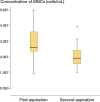
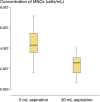
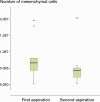
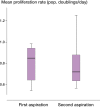
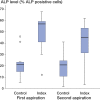
Similar articles
-
Benefits of small volume and small syringe for bone marrow aspirations of mesenchymal stem cells.Int Orthop. 2013 Nov;37(11):2279-87. doi: 10.1007/s00264-013-2017-z. Epub 2013 Jul 24. Int Orthop. 2013. PMID: 23881064 Free PMC article.
-
Isolation of clinically relevant concentrations of bone marrow mesenchymal stem cells without centrifugation.J Transl Med. 2019 Jan 5;17(1):10. doi: 10.1186/s12967-018-1750-x. J Transl Med. 2019. PMID: 30611285 Free PMC article.
-
Aspiration to obtain osteoblast progenitor cells from human bone marrow: the influence of aspiration volume.J Bone Joint Surg Am. 1997 Nov;79(11):1699-709. doi: 10.2106/00004623-199711000-00012. J Bone Joint Surg Am. 1997. PMID: 9384430
-
Mesenchymal stem cells for bone repair: preclinical studies and potential orthopedic applications.Foot Ankle Clin. 2005 Dec;10(4):651-65, viii. doi: 10.1016/j.fcl.2005.06.004. Foot Ankle Clin. 2005. PMID: 16297825 Review.
-
Advances of mesenchymal stem cells derived from bone marrow and dental tissue in craniofacial tissue engineering.Curr Stem Cell Res Ther. 2014 May;9(3):150-61. doi: 10.2174/1574888x09666140213142258. Curr Stem Cell Res Ther. 2014. PMID: 24524798 Review.
Cited by
-
Quantification of biological variation in blood-based therapy--a summary of a meta-analysis to inform manufacturing in the clinic.Vox Sang. 2015 Nov;109(4):394-402. doi: 10.1111/vox.12288. Epub 2015 Jul 14. Vox Sang. 2015. PMID: 26174339 Free PMC article.
-
Mesenchymal Stromal/Stem Cells in Regenerative Medicine and Tissue Engineering.Stem Cells Int. 2018 Aug 19;2018:8031718. doi: 10.1155/2018/8031718. eCollection 2018. Stem Cells Int. 2018. PMID: 30210552 Free PMC article. Review.
-
Reorientation technique has benefits in bone marrow aspiration of stem cells.Sci Rep. 2022 Jul 8;12(1):11637. doi: 10.1038/s41598-022-15019-7. Sci Rep. 2022. PMID: 35803965 Free PMC article.
-
Quick and effective method of bone marrow mesenchymal stem cell extraction.Open Med (Wars). 2014 Oct 8;10(1):44-49. doi: 10.1515/med-2015-0008. eCollection 2015. Open Med (Wars). 2014. PMID: 28352676 Free PMC article.
-
Perturbations of mesenchymal stromal cells after allogeneic hematopoietic cell transplantation predispose for bone marrow graft-versus-host-disease.Front Immunol. 2022 Oct 12;13:1005554. doi: 10.3389/fimmu.2022.1005554. eCollection 2022. Front Immunol. 2022. PMID: 36311725 Free PMC article.
References
-
- Bianco P, Robey PG. Stem cells in tissue engineering. Nature. 2001;414((6859)):118–21. - PubMed
-
- Brandao-Burch A, Utting J, Orriss I, Arnett T. Acidosis inhibits bone formation by osteoblasts in vitro by preventing mineralization. Calcif Tissue Int. 2005;77((3)):167–74. - PubMed
-
- Caplan A. Mesenchymal stem cells. J Orthop Res. 1991;9((5)):641–50. - PubMed
-
- de Boer J, Siddappa R, Gaspar C, van Apeldoorn A, Fodde R, van Blitterswijk C. Wnt signaling inhibits osteogenic differentiation of human mesenchymal stem cells. Bone. 2004;34((5)):818–26. - PubMed
-
- de Bruijn JD, van den Brink I, Mendes S, Dekker R, Bovell YP, van Blitterswijk CA. Bone induction by implants coated with cultured osteogenic bone marrow cells. Adv Dent Res. 1999;13((1)):74–81. - PubMed
MeSH terms
LinkOut - more resources
Full Text Sources
Other Literature Sources
